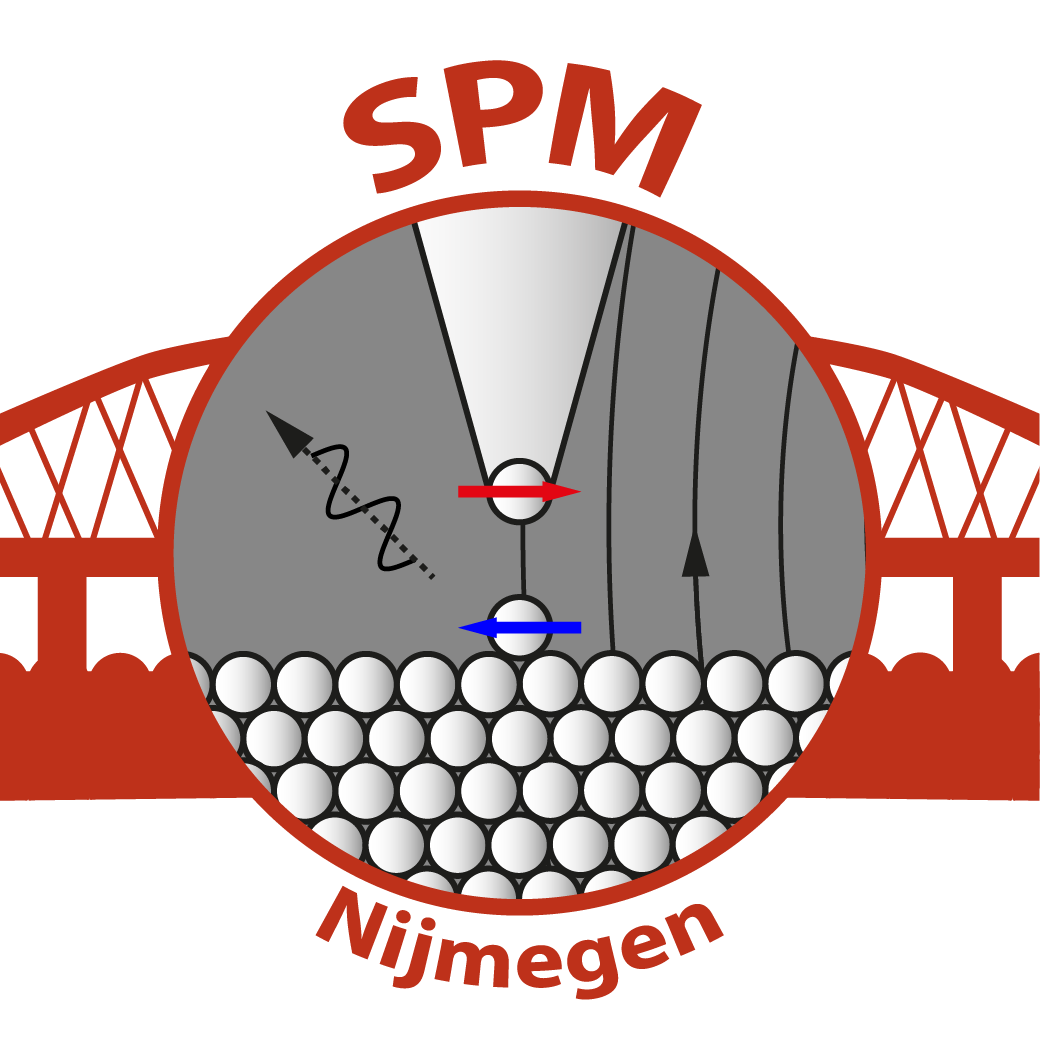Scanning Probe Microscopy
Radboud University, Nijmegen

Instrumentation & Laboratories
→ back to Research Overview
The IMM hosts, under the supervision the SPM department, a cluster of cutting-edge labs we call the SPiN labs (Scanning Probe in Nijmegen). The SPM department houses a broad range of instruments including scanning tunneling microscopes (STM) and atomic force microscopes (AFM), operating from ambient conditions down to the milliKelvin regime. The most recently constructed STILL lab facility, one of the quietest labs in the Netherlands, is situated three floors underground and is optimized for ultra-high precision measurements in large magnetic fields. It houses one of the highest resolution STMs in Europe, and is capable of vector-field magnetic characterization, including spin-polarized STM and ESR-STM.
All our microscopes are integrated in ultra-high vacuum systems, allowing for in-situ sample preparation (e.g. MBE, CVD). All instruments in the SPIN labs are heavily customized commercial or entirely home-built systems, based on strong in-house expertise in scanning probe technology, including multiple instruments capable of cryogenic operation, single-atom manipulation, and magnetic field-based measurements.
→ back to Research Overview
The IMM hosts, under the supervision the SPM department, a cluster of cutting-edge labs we call the SPiN labs (Scanning Probe in Nijmegen). The SPM department houses a broad range of instruments including scanning tunneling microscopes (STM) and atomic force microscopes (AFM), operating from ambient conditions down to the milliKelvin regime. The most recently constructed STILL lab facility, one of the quietest labs in the Netherlands, is situated three floors underground and is optimized for ultra-high precision measurements in large magnetic fields. It houses one of the highest resolution STMs in Europe, and is capable of vector-field magnetic characterization, including spin-polarized STM and ESR-STM.
All our microscopes are integrated in ultra-high vacuum systems, allowing for in-situ sample preparation (e.g. MBE, CVD). All instruments in the SPIN labs are heavily customized commercial or entirely home-built systems, based on strong in-house expertise in scanning probe technology, including multiple instruments capable of cryogenic operation, single-atom manipulation, and magnetic field-based measurements.
4K Omicron STM (Nanolab)
Operational temperature: 5-20 K. This facility is capable of spin-polarized tunneling and STM-induced luminescence at LHe temperatures. It has a He-hold time of almost 2 days, and has optical access to the STM, including a lens and ex-situ optical detection (single-photon counting module, grid spectrometer with LN2-cooled CCD). The facility is capable of in-situ growth of metallic overlayers as well as cold deposition of single atoms/molecules directly onto the sample inside the STM.
Operational temperature: 5-20 K. This facility is capable of spin-polarized tunneling and STM-induced luminescence at LHe temperatures. It has a He-hold time of almost 2 days, and has optical access to the STM, including a lens and ex-situ optical detection (single-photon counting module, grid spectrometer with LN2-cooled CCD). The facility is capable of in-situ growth of metallic overlayers as well as cold deposition of single atoms/molecules directly onto the sample inside the STM.
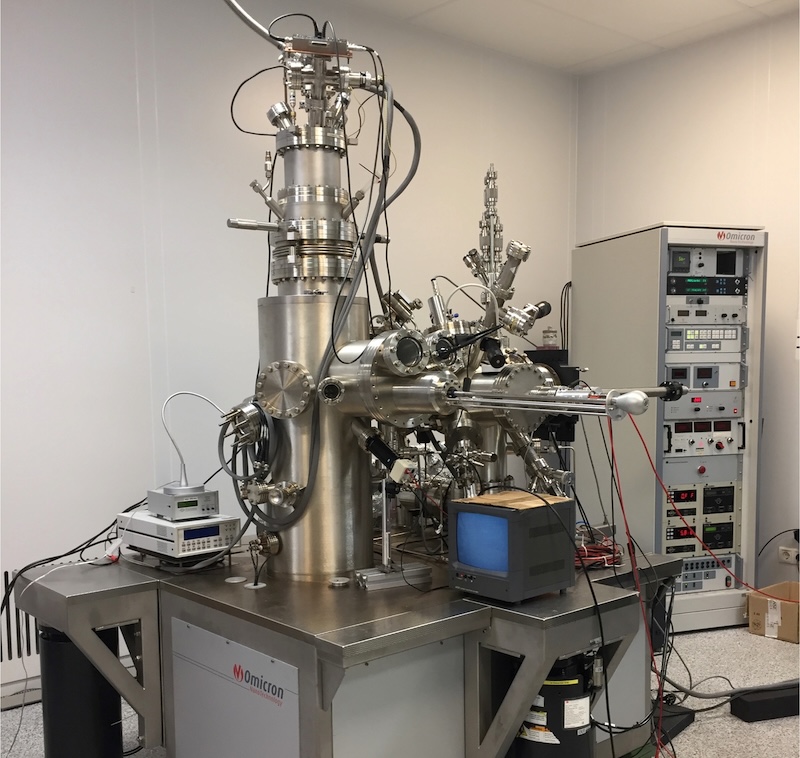
4K Createc STM/AFM (Nanolab)
Operational temperature: 5-20 K. This facility is capable simultaneous STM and AFM acquisition, based on the qPlus sensor design. Using magnetic tips, spin-polarized tunneling (SP-STM) and magnetic exchange force microscopy (MExFM) measurements can be performed simultaneously (SPEX). Th system has a hold time of almost 3 days, and has optical access to the STM. The facility is capable of in-situ growth of metallic overlayers as well as cold deposition of single atoms/molecules directly onto the sample inside the STM/AFM.
Operational temperature: 5-20 K. This facility is capable simultaneous STM and AFM acquisition, based on the qPlus sensor design. Using magnetic tips, spin-polarized tunneling (SP-STM) and magnetic exchange force microscopy (MExFM) measurements can be performed simultaneously (SPEX). Th system has a hold time of almost 3 days, and has optical access to the STM. The facility is capable of in-situ growth of metallic overlayers as well as cold deposition of single atoms/molecules directly onto the sample inside the STM/AFM.
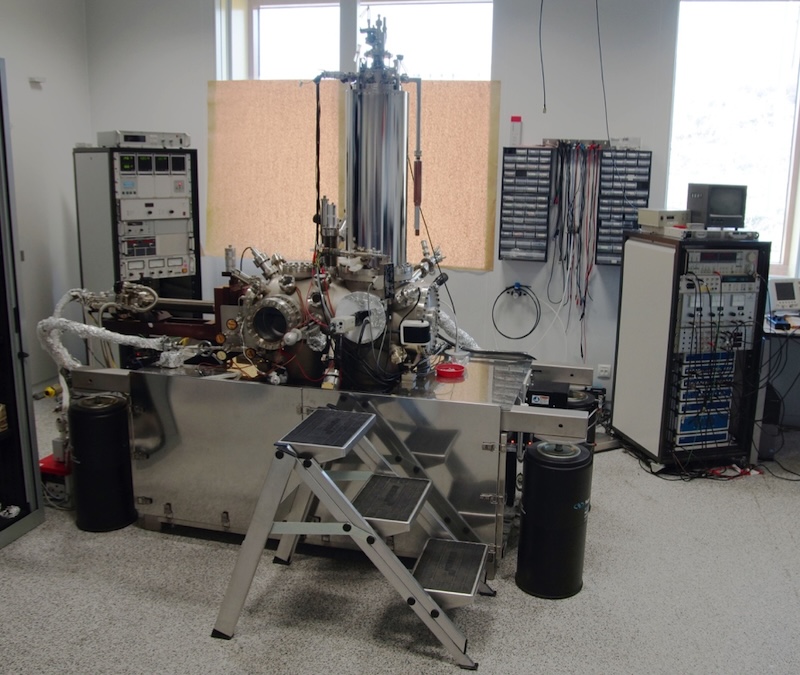
1 K – 9 T SP-STM (Spacelab)
Operational temperature: 1-20 K. This facility is capable of spin-polarized tunneling at 4He temperatures and can be cooled down to 1.2 K via a 4He Joule-Thomson closed cycle. The system has a hold time of approximately 7 days. It contains two additional MBE chambers and CVD capabilities for growth of samples and tips in situ. It also contains a 9T solenoid superconducting magnet for out-of-plane application.
Operational temperature: 1-20 K. This facility is capable of spin-polarized tunneling at 4He temperatures and can be cooled down to 1.2 K via a 4He Joule-Thomson closed cycle. The system has a hold time of approximately 7 days. It contains two additional MBE chambers and CVD capabilities for growth of samples and tips in situ. It also contains a 9T solenoid superconducting magnet for out-of-plane application.
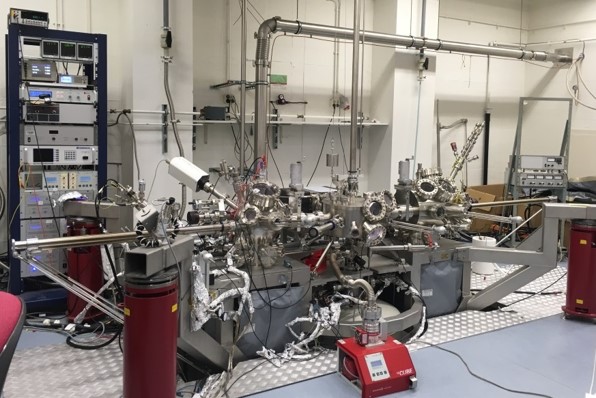
30 mK – 9/4 T SP-STM (Still lab)
Operational temperature: 30 mK - 7 K. This facility is capable of spin-polarized tunneling and operates within a wet top-loading dilution fridge (Janis JDR-50, cooling power 115 µW). Furthermore, the system is equipped with high-frequency cabling permitting pump-probe and spin resonance measurements. It has a hold time of approximately 7 days. The facility contains two additional MBE chambers and CVD capabilities for growth of samples and tips in situ. It also contains a 9T solenoid and a 4T split-coil magnet, capable of vector mode operation in a 2D plane (up to 3T). For details, please see our publications [1,2].
Operational temperature: 30 mK - 7 K. This facility is capable of spin-polarized tunneling and operates within a wet top-loading dilution fridge (Janis JDR-50, cooling power 115 µW). Furthermore, the system is equipped with high-frequency cabling permitting pump-probe and spin resonance measurements. It has a hold time of approximately 7 days. The facility contains two additional MBE chambers and CVD capabilities for growth of samples and tips in situ. It also contains a 9T solenoid and a 4T split-coil magnet, capable of vector mode operation in a 2D plane (up to 3T). For details, please see our publications [1,2].
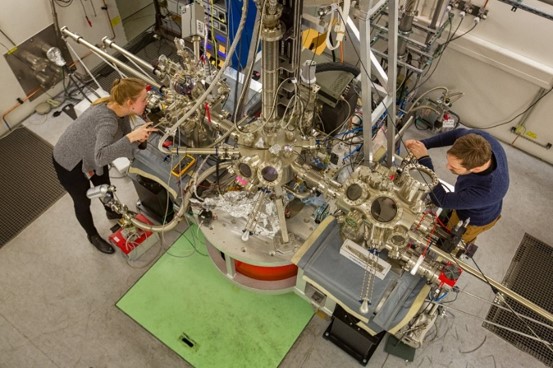
6 mK – 9/4 T SP-STM (Still lab)
(under development)
Operational temperature: 6 mK - 7 K. This facility is capable of spin-polarized tunneling and operates within a wet top-loading dilution fridge (Janis JDR-250, cooling power ca. 210 µW). Furthermore, the system is equipped with high-frequency cabling permitting pump-probe and spin resonance measurements. It has a hold time of approximately 7 days. The facility contains two additional MBE chambers and CVD capabilities for growth of samples and tips in situ. It also contains a 9T solenoid and a 4T split-coil magnet, capable of vector mode operation in a 2D plane (up to 3T).
(under development)
Operational temperature: 6 mK - 7 K. This facility is capable of spin-polarized tunneling and operates within a wet top-loading dilution fridge (Janis JDR-250, cooling power ca. 210 µW). Furthermore, the system is equipped with high-frequency cabling permitting pump-probe and spin resonance measurements. It has a hold time of approximately 7 days. The facility contains two additional MBE chambers and CVD capabilities for growth of samples and tips in situ. It also contains a 9T solenoid and a 4T split-coil magnet, capable of vector mode operation in a 2D plane (up to 3T).
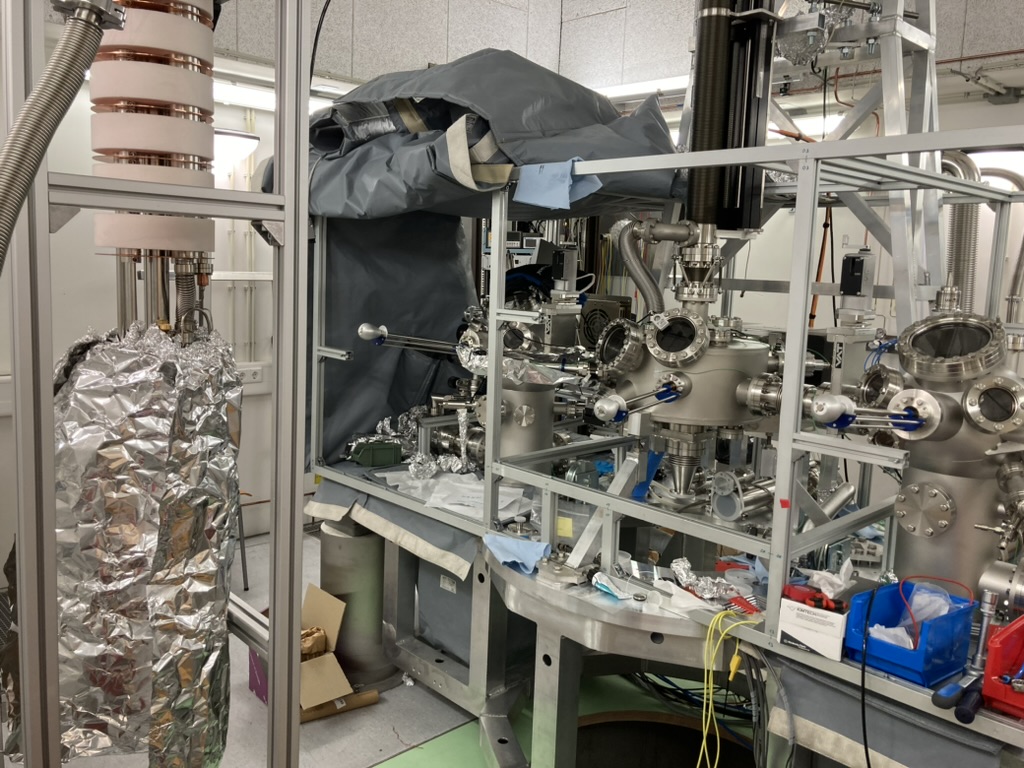
Still lab concept
In order to be able to acquire measurements in an ultra-quiet environment (concerning vibrational, acoustic, and electromagnetic noise), we have designed and built the STILL labs in Nijmegen, hosting two lab rooms whose walls and foundation are not in contact with the main building [1]. The lab floor is a 150-ton concrete block resting on six damping springs, which allows for the whole laboratory to be floated during measurements. The room has high clearance and a pit, permitting an in-situ transfer of samples from the UHV system into the magnetic cryogenic STM. The labs are RF-shielded by a Faraday cage, with ca. 60 dB attenuation. Acoustic panels on the walls and ceiling as well as special filters for the air ventilation suppress the impact from airborne acoustic noise. Next to each lab, there is also an additional room for noisy mechanical pumps which is decoupled mechanically and acoustically from the quiet lab space. The lab was completed in late 2015. One room hosts the 30 mK STM setup. The second room will be used for a new 6 mK setup.
In order to be able to acquire measurements in an ultra-quiet environment (concerning vibrational, acoustic, and electromagnetic noise), we have designed and built the STILL labs in Nijmegen, hosting two lab rooms whose walls and foundation are not in contact with the main building [1]. The lab floor is a 150-ton concrete block resting on six damping springs, which allows for the whole laboratory to be floated during measurements. The room has high clearance and a pit, permitting an in-situ transfer of samples from the UHV system into the magnetic cryogenic STM. The labs are RF-shielded by a Faraday cage, with ca. 60 dB attenuation. Acoustic panels on the walls and ceiling as well as special filters for the air ventilation suppress the impact from airborne acoustic noise. Next to each lab, there is also an additional room for noisy mechanical pumps which is decoupled mechanically and acoustically from the quiet lab space. The lab was completed in late 2015. One room hosts the 30 mK STM setup. The second room will be used for a new 6 mK setup.
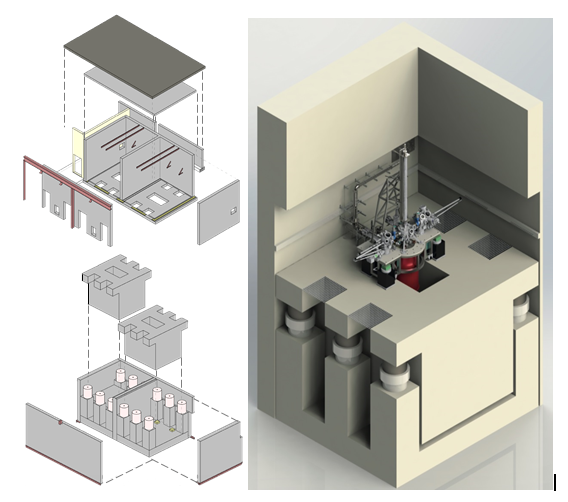
References
- H. von Allwörden, A. Eich, E. J. Knol, J. Hermenau, A. Sonntag, J. W. Gerritsen, D. Wegner, A. A. Khajetoorians, Design and performance of an ultra-high vacuum spin-polarized scanning tunneling microscope operating at 30 mK and in a vector magnetic field, Review of Scientific Instruments 89, 033902 (2018).
- W. M. J. van Weerdenburg, M. Steinbrecher, N. P. E. van Mullekom, J. W. Gerritsen, H. von Allwörden, F. D. Natterer, A. A. Khajetoorians, A scanning tunneling microscope capable of electron spin resonance and pump–probe spectroscopy at mK temperature and in vector magnetic field, Review of Scientific Instruments 92, 033906 (2021).
